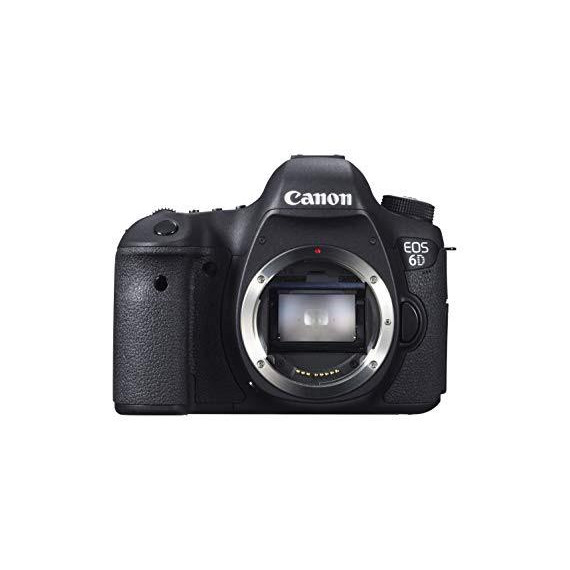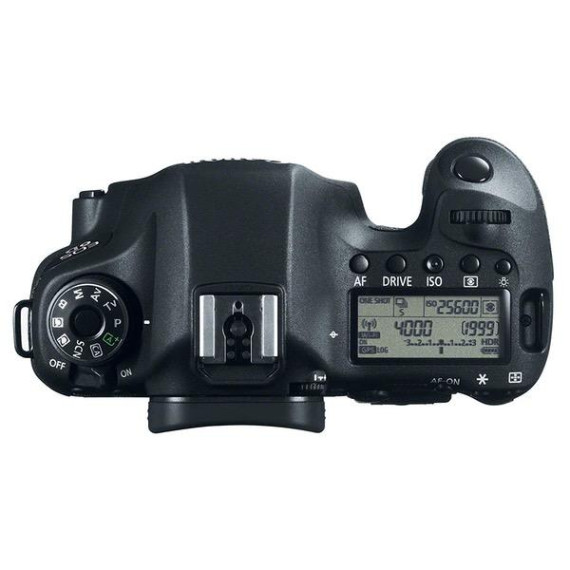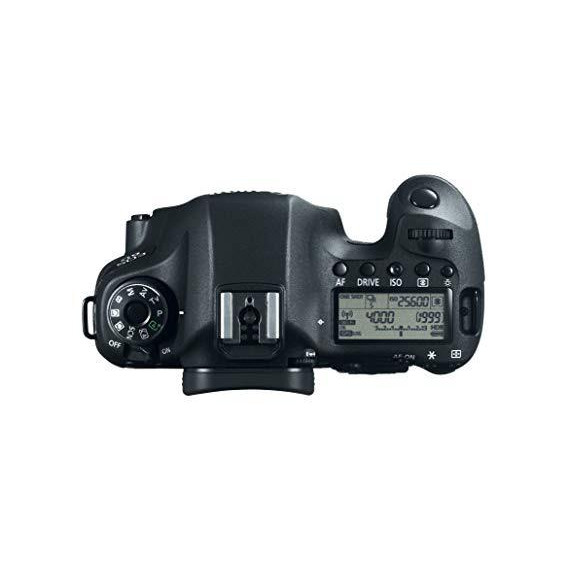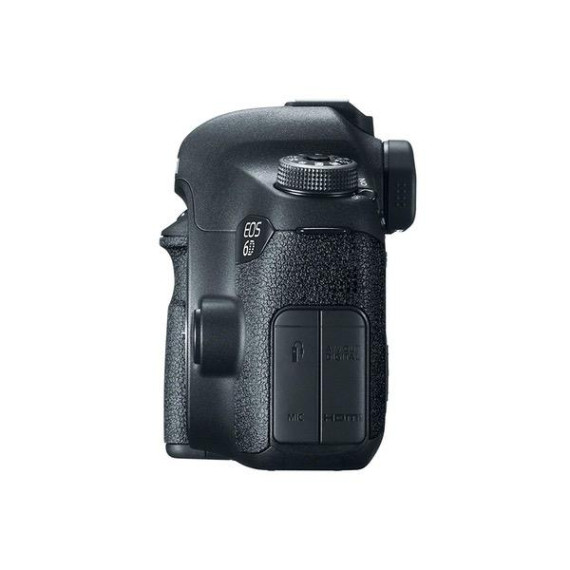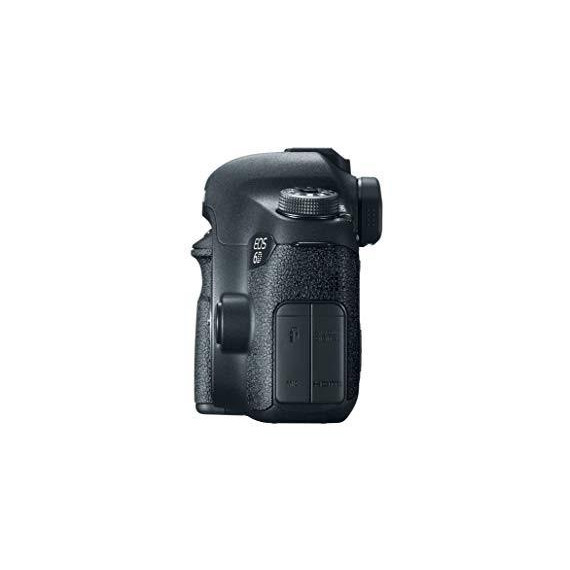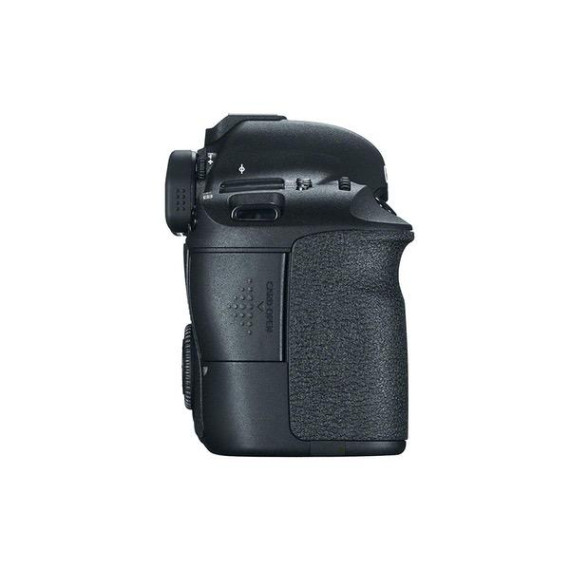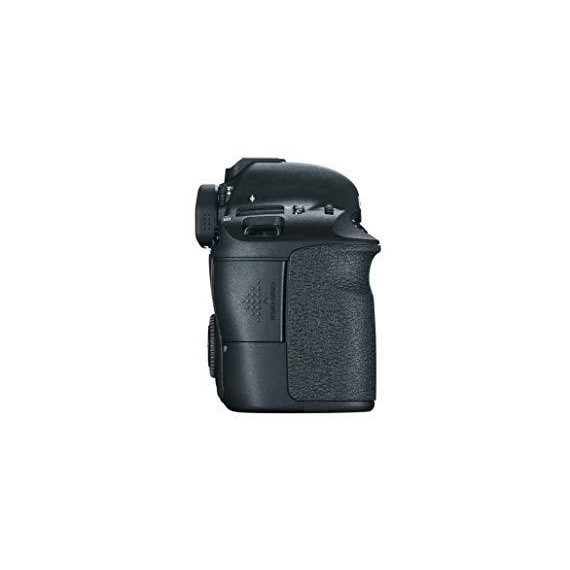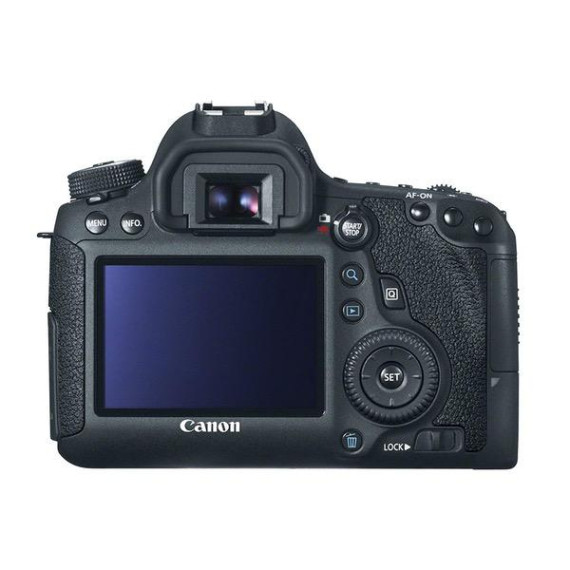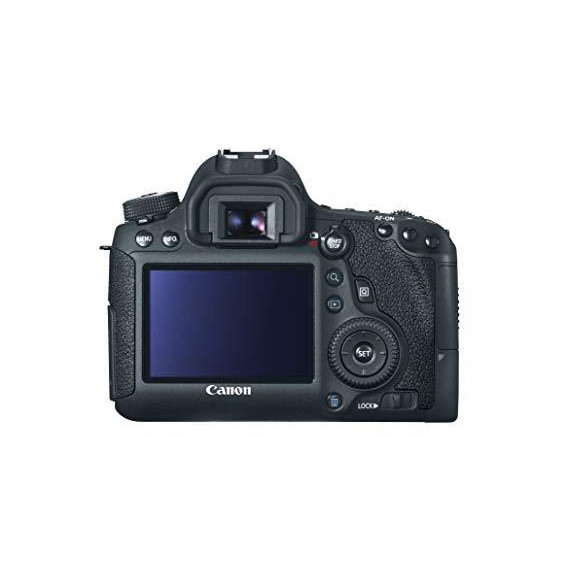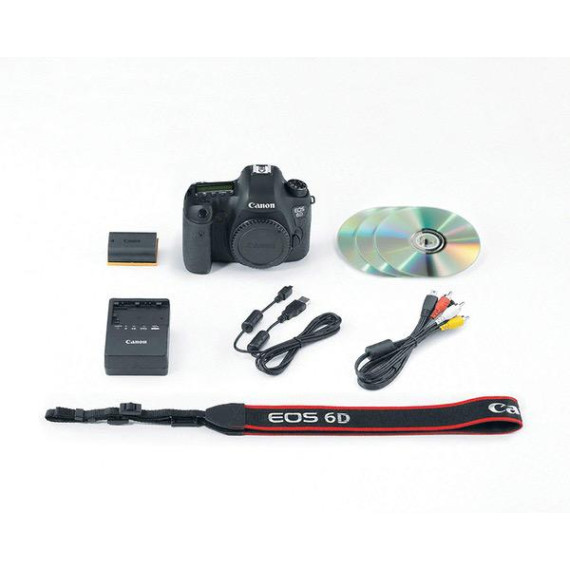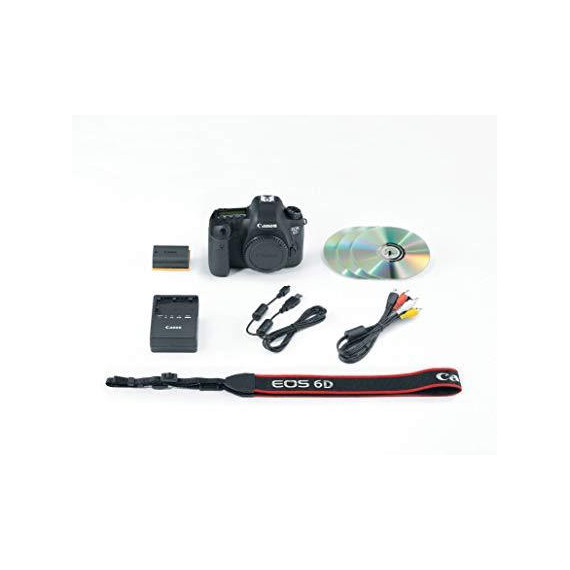D. Alexander
This camera has top-tier image quality in a polished, compact package well-suited to travel. Those upgrading from a 5D II or 7D may prefer the sharp response and focusing performance of the 5D III. Buyers without an investment in the Canon system may find Nikons D600 a better value. Ive finally had enough of a hands-on with this camera to draw some conclusions about it. My main body is a 5D II and Ive owned or used almost all of Canons crop bodies. HANDLING AND NEW FEATURES: Build quality on first impression is similar to the 60D and 5D II. Solid enough, with a slightly narrower grip than most previous Canon bodies, those two inclusive, but still comfortable to my large hands. This body is petite for full-frame, about 10% smaller by volume than the 5D II and 15% under the 5D III. Weight is similarly svelte, below every 5D and the 7D, and about even with the 60D. The larger cameras will balance a bit better with heavy lenses; this 6D will be the preferable travel body by a small margin. New relative to the 5D II are improved weather sealing and a much-appreciated mode dial lock. Its not clear how comprehensive the sealing is; I still wouldnt take it in the rain, and very few non-L Canon lenses are weatherproof. The LCD screen has a fatter aspect ratio and somewhat better contrast. As seems to be the new Canon norm, the 6D has mushy buttons that activate at some indeterminate point. Novel, however, is the button layout. The top panel retains the 60Ds configuration of four buttons, each with one function. The 5D series, 7D, and prior XXD models have three buttons with two functions per. You lose direct adjustment of flash exposure compensation and white balance, but frankly, most people will find this simplified layout preferable. I still forget which dial controls which function on my 5D II. The rear panel looks superficially like the 60D with the same right-hand bias, though the functionality has been shifted around. A mitigating factor is that, as on the 7D, 60D, and subsequent bodies, you can bind custom functions to many buttons. I didnt find it a major trial to adapt from the 5D II, but youll definitely want to spend a few days with it before you have to work under pressure. Rebel owners will find the adjustment more significant. This 6D has a single SD card slot. The 5D II uses CF, which is rapidly becoming the purview of only high-end bodies. CF is faster, harder to lose, and costs more. SD is fast enough for a body in this speed class. This is nonfactor unless you have a sizeable collection of the opposing format. The 5D III has a dual slot that can speed some workflows and provide media redundancy. Like all Canon full-frame DSLRs, this body doesnt have a popup flash. Im not lamenting the absence, it was a bone to casual shooters more than a serious tool. Max sync speed for most Canon bodies is around 1/200, so integrated flash only works for outdoor fill with narrow apertures. Indoors as a main light source, the tiny size and close proximity to the lens lead to red eyes and a flat, unflattering high-contrast look. A much preferable setup for any Canon DSLR pairs a 430EX or 580EX, ideally diffused or aimed to bounce off a nearby surface. Shutter lag now rivals the 5D III and 40D-7D, a few ticks quicker than the 5D II and any of the Rebels. This responsiveness bodes well for the first shot. Later shots come at 4.5 fps, a rate ideal for candids, but not for sports. The 5D II and III are respectively worse (3.9 fps) and better (6 fps). Of greater interest: like the 5D III, the 6D now has a silent shooting mode that lowers the volume and pitch of the mirror clunk by half. Every wedding Ive ever shot would have benefited from that. The screen interface follows the mold of every Canon body since the 40D. It has a series of horizontal tabs with options. The major UI change is that instead of 9 tabs that also scroll vertically, you get 15 that dont. The advantage is that you can rapidly wheel through tabs and see everything there is to see without scrolling; the disadvantage is that it looks intimidating and there are multiple tab groups of the same icon. The Creative modes show every tab. Some are hidden in Program and Auto modes. Weve done a full about-face since the original 5D, which had a handful of tabs and piles of scrolling. A major new feature also common to the 5D III is a better implementation of Auto-ISO. Its often the case in changing light where you want to shoot a lens wide open for subject isolation, but with a fixed or minimum shutter speed so you wont risk motion or hand blur. On the 5D II, that was a no-go; Auto-ISO didnt work in Manual mode and the minimum shutter chosen in the other modes was too low. This camera will do Auto-ISO in M between any lower and upper bound you choose. Or you can set a minimum shutter for Av or P mode. Wonderful and overdue, this. Some other new features are worthy of note. Theyve added a single-axis level thats useful for landscapes and architecture. The GPS feature will tag images with a location and can also keep a constant breadcrumb position log (at significant cost to battery life) that you can layer on a map later. And theyve added wireless networking, so you can control the camera by smartphone or laptop with a live video feed. I can do that with my 5D II, but it requires a cable or USB-wireless converter dongle. In theory, you can also upload to Facebook by way of a Canon bridge website, but I didnt test this. AUTOFOCUS: AF is a marginal improvement over the 5D II. Performance and customizability are somewhat better, but usability suffers. First, context: unlike a phone, point-and-shoot, or mirrorless body, DSLRs dont use the image sensor ("contrast detect") to focus for still photography through the viewfinder. That means you dont get face detection or any sort of scene recognition at all. Instead, youve got a handful of AF points in a diamond configuration. Each point covers a tiny area of the frame. If you let the camera choose the point, itll pick whichever is sitting on a contrasting edge (i.e., a clear dark/light edge; anything that isnt a flat color). Maybe thatll be an eye. It could just as easily be a button. The first major habit to acquire with a DSLR is picking your own focus points. The easier that is, the faster you can accurately shoot. On the 5D II, theres a joystick on the back to individually select any of the 9 AF points with a single click. The phase sensor has 6 invisible AF-assist points to help track motion. Minimum light to focus with the center cross-point is -0.5 EV; in my case, that translated to an exposure of 1/50, f/2, ISO 25600 with a 100/2. Very dim, but not impossible to see and not out of the ISO capacity of this body or certainly the 6D. Shooting by moonlight or dim exterior lighting could benefit from greater AF sensitivity. The 6D excels in this area. The center point is rated to -3 EV, a full 2.5 stops below the 5D II and is, in theory, at least a stop under any other Canon DSLR. Theres essentially no handheld exposure, even with an f/1.4 or f/1.2 lens, for which this camera wont catch focus. But its missing the 5D IIs joystick; you have to awkwardly shift your thumb further down to use a less precise 8-way rocker panel. If you choose not to bind AF to the shutter button, youll wear out that digit in a hurry. Also, the system now has 11 AF points (with no additional coverage), so you cant directly select the two outer points anymore. As to motion tracking, the 6Ds AF diagram suggests it may also have 6 or 8 AF-assist points. The manual doesnt say, and if they exist, theyre not selectable. Either way, the same rules from the 5D II apply: if youre tracking a high-contrast object centered in the viewfinder in decent light, it works well enough. All bets are off if you need to rely on the outer points. Likewise for using the outer points with wide-aperture lenses; they dont always hit. Youll want to take a lot of safety shots if focus is critical. There are a few new custom functions to fine-tune AI Servo. As with the 5D II, the 6D supports AF microadjustment, though now with separate settings for the wide and long ends of zoom lenses. Also interesting is the ability to link the AF point with camera orientation; helpful if youre switching from portrait to landscape repeatedly. To the extent its possible to narrow a wide array of AF characteristics to a 10-point scale, heres how Id subjectively rate Canons various bodies: Center point / Outer points / Motion tracking | Body 9 / 9 / 8 | 5D III 6 / 6 / 6 | 7D 6 / 5 / 5 | 40D/50D/60D/T4i/T5i 8 / 3 / 4 | 6D 6 / 3 / 4 | 5D II 6 / 3 / 3 | T2i/T3i/SL1 Some scenarios will show greater disparities than these numbers suggest. A 6D in very dim light may well catch focus where every other body on this list fails. Likewise, very fast or erratic objects may flummox every camera here but the 5D III. Ive ranked the 5D IIIs center point higher because, while it cant match the 6D in moonlight, it has significantly higher accuracy and consistency with recent Canon lenses. STILLS IMAGE QUALITY: Very good. Per-pixel sharpness is very high and superior to crop bodies-- par for the course for a full-frame sensor near this pixel density. Dynamic range is similar to the 5D II and 5D III. Noise performance in raw is a third-stop better than the 5D III, one stop ahead of the 5D II, and a little over 2 stops past the T2i/T3i/60D/7D. Id run this body to ISO 12,800 without much thought. Colors at low ISO are indistinguishable from any other Canon DSLR. Shadow noise has improved over earlier bodies. A common shooting technique is to meter for highlights and raise the shadows in post to make darker details visible, the manual equivalent of Canons Auto Lighting Optimizer. Boosting the shadows with a 5D II eventually reveals banding patterns and a blue cast. The 5D III fixes the banding, but retains the color cast. The 6D doesnt have either. While Nikon still holds a significant lead on this point, 6D files are cleaner than every other Canon body save the 1D X. To get the most out of this DSLR, youll want to shoot raw. Raw lets you defer decisions (e.g., white balance, sharpening, noise reduction, color, distortion, tone curves, exposure, and so on) that distract from catching whatever moment youre after. Adjustments to raw files in post are vastly more flexible than the Picture Styles that control the 6Ds JPEG engine. Those provide only rudimentary adjustments to tone, sharpening, and color. With challenging lighting (mixed white balance, high or low dynamic range, or changing light), Picture Styles can give a suboptimal result, complicated in part by metering. In low-dynamic-range scenarios (e.g., a cloudy day), evaluative metering tends to give a dull, low-contrast picture. With a high DR scene (e.g., a sunny day with deep shadows), blown highlights and clipped shadows will be exacerbated by a high-contrast Picture Style set for the earlier scene. If youre careful configuring the body and the stars align, you can get decent JPEG output and forego work in post, but I consider a fast computer and a photo management system like Adobe Lightroom to be less complements than necessities. LENSES: I want to segue into this section because its entwined with image quality. Comparing full-frame and crop isnt quite apples to apples. Its much easier to find crop lenses with good edge performance. Canons current full-frame DSLRs make hash of almost all the mid-range variable-aperture zooms theyve released over the years. I was pleased with my 28-135/3.5-5.6 IS on my 40D. Very consistent sharpness across the frame, even wide open. On full-frame, the same lens falls down. Poor edge performance, lots of aberrations. Expect to pay 30-100% more on glass to feed this camera relative to EF-S lenses. Full-frame L glass costs a mint, but most of the third-party wide to mid-focal lenses dont emphasize edge performance. Ive used a 14/2.8, 17-40/4, 16-35/2.8 II, 24-105/4, 100/2, and 200/2.8 among others. The latter two are stellar across the frame, as is the Samyang ultrawide. The 24-105/4L, 17-40/4L, and 16-35/2.8L II are merely good. None perform that well in the corners at wide apertures. Older wide-angles like the 17-35/2.8 fare even worse. What should your kit be? Some considerations: * Primes are lighter, smaller, cheaper, often available in wider apertures, often optically better, and have less manufacturing variation. Theyre less convenient, less versatile, updated with new technologies (e.g., stabilization, better lens coatings, weight reductions, faster or more accurate AF) less often, and can cause you to miss shots in fast-paced shooting environments. * There are different requirements for movie lenses and still lenses. No Canon full-frame zooms are optimal for movies. Some are more optimal than others (e.g., less focus breathing, more parfocal, less distortion, smoother operation, distance scale). Primes often fare better. * An f/2.8 lens on this body is just fast enough for most indoor use without flash. Youll want a flash for anything slower. A flash can provide more even, pleasing pictures, at the expense of a bulkier, attention-attracting rig. * Kits with more than three primary lenses can become unwieldy in use. Two are preferable. My walkaround kit is a 16-35/2.8 and a 100/2, or a 24-105/4 alone if I expect to shoot movies. Professional event shooters tend to rely on the 16-35/2.8, 24-70/2.8, 70-200/2.8, and faster primes like the 85/1.2 as necessary. * Third-party lenses tend to have less upfront cost, better warranties, and more aggressive designs. AF and optical performance is often (but not always) inferior to OEM lenses, quality control is less consistent, and resale values are lower. Value varies by lens model. Some are better than the OEM equivalents (e.g., Tamron 70-300 VC, Sigma 35/1.4). Some fill holes in the OEM lineup (e.g., Sigma 120-300/2.8 OS). And some are lesser substitutes, but still competitive (e.g., Sigma 70-200/2.8 OS, Tamron 70-200/2.8 VC). Third-party lenses that duplicate the OEM with similar performance may not always be preferable to used copies of the OEM model. VIDEO: Out of the box, 6D video has five characteristics: lovely depth-of-field-control with the right lenses, clipped colors, high contrast, about 720p worth of actual detail at the 1080p setting, and issues with aliasing and moiré common to most Canon DSLRs. Moiré (false coloring and an interference pattern on subjects with repeating fine detail) in particular is more noticeable than with the 5D II and well behind the 5D III. There are a few improvements over the 5D II. Canon has added time code support for better synchronization of events in post and superior on-camera editing controls. We now have 720p/50 and 720p/60 to complement the 1080p/25 and 1080p/30 modes. The compression algorithm is better, as is noise performance, and theres a slightly superior (though still quite slow) contrast-detect focusing algorithm. Unbelievably, Canon still hasnt included focusing aids for manual focus. Its very difficult to judge focus from the LCD screen without overshooting and undershooting. Professionals that have to focus on the fly use a magnifier that sits on top of the LCD or rely on focusing aids in Magic Lantern, a third-party piggyback firmware available for the 5D II (but not yet for the 6D). For that reason alone, video here remains very much a professional feature. In terms of post-processing flexibility, Canon EOS video is like shooting JPEG, but worse because the H.264 video codec throws away even more unseen data. You have none of the lossless adjustability of raw, so its pivotal to lower contrast to preserve detail in the highlights and shadows, dial back the colors to prevent clipping, and lower sharpening so you can add it back in post without causing nasty artifacts. You do that by setting the correct white balance in advance and by creating or downloading a custom tone curve with low contrast, color, and sharpening. The latter wont affect your stills if you shoot in raw, so you can cater it solely to video. Camera shake is another issue. If youre going to shoot without a tripod or Steadicam rig, get a stabilized lens. In fact, just buy the 24-105/4L IS. No other lens has the combination of size, weight, edge performance, range, stabilization, consistent aperture, speed, and partial parfocal (holding focus through the zoom range) ability. The next best choice might be something like the Tamron 24-70/2.8 VC or Canons upcoming 24-70/4L IS. Anything over 50mm that isnt stabilized will challenge your ability to record smooth footage. You can fix that later by transcoding to an editable format and using the anti-shake facilities of Adobe Premiere, Sony Vegas, or Virtual Dub with Deshaker, but thats a pain and they all crop the frame. Start with stabilization from the outset and save yourself the bother. Stabilized lenses cause a new problem: the IS system is audible on the audio track. Its obvious with the 70-200/4L IS, noticeable with the 24-105/4L IS, and a background hum with the 70-200/2.8L IS I/II. Thats in addition to dial clicks, finger movement, and wind noise, which obscure what would be fairly mediocre sound quality in the best case. The 6D records CD-quality 48 KHz 16-bit stereo tracks; the fault is with the internal monaural mic and amplifier. The simplest, most portable solution is to attach an external battery-powered mic to the flash hotshoe. The two most popular are around $250 from Rode. Zooms H1 stereo recorder is a cheaper, more versatile alternative that can also be camera-mounted. ACCESSORIES: For video, buy SD cards 32 GB or larger. My pair of 16 GB cards have been inadequate for even a one-day event. Choose SanDisk. Ive never had a SanDisk card of any size fail, they maintain higher resale value than other brands, and they tend to write somewhat faster than competitors with the same speed rating. Interface responsiveness isnt much affected by card speed. Faster cards have three advantages: they can shoot longer bursts at 4.5 FPS, clear the picture buffer more quickly, and fulfill Canons write speed requirement of 20 MB/s to record video at the highest quality. Buffer depth is 17 raw files with a UHS-1 (Ultra High Speed) SD and 14 with a conventional card. Buffer cycling times are much lower with UHS-1. In one-shot mode, this difference is invisible; very fast cards would only make sense if you were time-limited on card-to-computer transfers with a USB 3.0, SATA, or Firewire card reader. If you buy protection filters for your lenses, try Hoyas "DMC PRO1 Clear Protector Digital" line. They have very high light transmission and dont cause visible flare. Digital sensors filter UV natively, theres no reason to pay more for that feature. Ive written reviews on the relevant Hoya product pages with more details and why you might (or might not) want a filter. Third-party batteries are hit or miss. The 6D wont read the charge capacity of many LP-E6 copies that worked fine with earlier bodies. STK has a battery chipped specifically for this camera thats worth considering. Compatibility aside, Canon OEM batteries tend to retain more charge capacity for a longer period. Your call whether thats worth five times the price. NIKON D600 VS 6D: (+) Focus tracking (+) Focuses with f/8 lenses vs. f/5.6 (e.g., f/5.6 lens + 1.4X TC) (+) 24 vs 20 MP (+) Shadow noise at low-ISO (+) 5.5 vs 4.5 fps (+) Dual-SD slots (+) DX crop mode (+) Headphone monitoring port (+) Pop-up flash (+) More physical controls (+) Auto-ISO even better (-) No GPS (-) No Wifi (-) Center-point focus in very low light (-) Noise at high-ISO (-) Live View mode more limited (-) Larger, heavier (-) Early copies were prone to accumulating sensor cruft On balance, while the 6D is a fine evolution of two older bodies (the 5D II and the 60D), the D600 is a simply a tier above in specification. The two brands give and take on the system level; Canon has a better service department and an edge with telephoto zooms and tilt-shift. Nikon has the best wide-angle zoom available on any mount. Consider the cost of your likely kit before judging by body prices. SHOULD YOU BUY A 6D? * If youre new to DSLRs: Yes, with caveats. DSLRs give you lens flexibility, subject isolation, better low-light performance, and potentially superior motion tracking. Theyre also bulky, expensive, a suboptimal design for video, and inconsistent in the point-and-shoot modes. Mirrorless designs are more compact, easier to use, and better for video, but not as capable for stills or movement. Prosumer single-lens cameras are smaller, much cheaper, and with jack-of-all-trades functionality that less demanding users may find preferable. Relative to crop DSLRs, full-frame bodies like the 6D give you better low-light performance. They cost more, require larger and more expensive lenses, and tend to be somewhat less responsive to fast action outside of the top product tiers. If youve settled on full-frame, the two chief competitors are Canon and Nikon. Canon is a bigger company with a wider, more modern, and more readily available lens line, but it also tends to have more rigid product segmentation that can leave lower camera bodies wanting for some features. If you can swing the cost, both companies produce products capable of almost any photographic endeavor. Among Canons full-frame line, the choice is between an old new-stock 5D II, 6D, and 5D III. The 5D III is a faster body with extras like dual card slots that professionals appreciate. It also has a dramatically superior AF system for motion tracking and automatic AF point selection. Given that f/2.8 full-frame zoom lenses start at over $1000, the 6Ds $800 price advantage over the 5D III on sale isnt enormous in the larger scheme. Something to consider if your subjects move a lot. The 5D II is fine if discounted 20% relative to the 6D; at the same price, Id take the 6D for the new sensor, silent shutter, and Auto-ISO. * If you have a Canon Rebel DSLR before the T4i: Yes, if youre willing to trade comparatively cheap and small EF-S lenses for stellar noise performance, a bright viewfinder, superior low-light focusing, and a rear control dial, among the 6Ds other enhancements. * If you have a Rebel T4i, 60D, or 7D: Same as above, but youre also trading speed and motion tracking, and the 6D doesnt gain as much in usability. A 60D isnt far removed from this 6D in feel. The 7D is a league apart: a league of amphetamines. If you want speed, low noise, and even better AF tracking, the 5D III is your body. * If you have a 5D II: No, if youre shooting predominately raw. Theres little functionality in the 6D that cant be added to the 5D II and the bodies are very similar in capability. The exception is very low-light shooting. Moonlight, street-shooting at night, or star trails that benefit from locking onto a faint point source to set infinity will all be easier on a 6D, and the extra noise performance doesnt hurt. Youre likely to miss the 5D IIs AF joystick. IN SUM: I like this camera body. Stills image quality is extraordinary, and for that purpose, theres little to fault. Taken in isolation, the 6D is an enormously capable and polished photographic instrument, and $600 less than the 5D II was in 2008. The quibbles appear when you consider it in the context of the larger market. Its an expensive camera with many of the same faults and limitations that were laboriously documented in the 5D II four years ago. The competition hasnt been resting on laurels; quality control aside, Nikons D600 is more capable in many ways and similarly priced. Id still choose Canon on the strength of the Canon system, but others may find greater value elsewhere. If you intend to downvote, please leave a comment so I can correct the issue.




